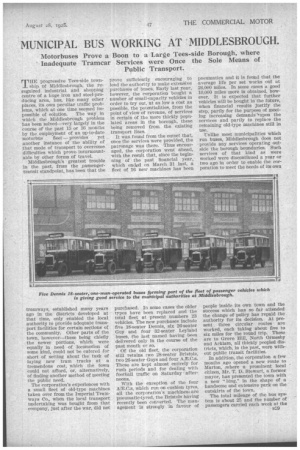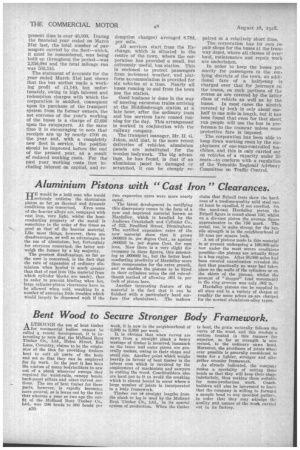MUNICIPAL BUS WORKING AT 'MIDDLESBROUGH.
Page 13

Page 14

If you've noticed an error in this article please click here to report it so we can fix it.
Motorbuses Prove a Boon to a Large Tees-side Borough, where Inadequate Tramcar Services were Once the Sole Means of Public Transport.
T" progressive Tees-side township of Middlesbrough, the recognized industrial and shopping centre of a huge iron and steel-producing area, has, like many other places, its own peculiar traffic problems, which at one time seemed im
possible of solution. The way in which the Middlesbrough problem has been solved—very largelY in the course of the past 15 or 16 months by the, employment of an up-to-date motorbus fleet — provides yet another instance of the ability of that mode of transport to overcome difficulties which prove, insurmountable by other forms of travel.
Middlesbrough's greatest trouble in the past, from the passengertransit standpoint, has been that the tramways, established many years ago in the districts developed at that time, only enabled the local authority to provide adequate transport facilities for certain sections of the community. Other parts of the town, however—these being chiefly the newer portions, which were equally in need of locomotion of some kind, could not be catered for short of setting about the task of laying new tram tracks at a tremendous cost, which the town could not afford, or, alternatively, of finding another method of meeting the public need.
The corporation's experiences with a small fleet of old-type machines taken over from the Imperial Tramways Co., when the local transport undertaking was bought from that company, just after the war, did not prove sufficiently encouraging , to lead the authority to make extensive purchases of buses. Early last year, however, the corporation bought a number of small-capacity vehicles in order to try out, at as low a cost as possible, the potentialities, from the point of view of revenue, of services in certain of the more thickly populated areas in the borough, these being removed from the existing transport lines.
It was found from the outset that, once the services were provided, the patronage was there. Thus encouraged, the corporation went ahead, with the result that, since the beginning of • the past financial year, which encl.zd on March. 31 last, a fleet of 16 new machines has been purchased. In some cases the older types have been replaced and the total fleet at present numbers 23 vehicles. The new purchases include five 18-seater Dennis, six 26-seater Guy and four 32-seater Leyland buseS, the last named having been delivered only in the course of the past month or so.
Of the old fleet, the corporation still retains two 28-seater Bristols, two 26-seater Guys and four A.E.C.s. These are kept almost entirely for rush periods and for dealing with football traffic on Saturday afternoons.
With the exception of the four A:E.C.s, which run on cushion tyres, all the corporation's machinesi, are pneumatic-tyred, the Bristols having recently been coriverted. The management is strongly in favour of pneumatics and it is found that the average life per set works out at 26,000 miles. In some cases a good 10,000 miles more is obtained, however. It is expected that further vehicles will be bought in the future, when financial results justify the Step, partly for the purpose of meeting increasing demandOupon the services and partly to replace the remaining old-type machines still in use.
Unlike most municipalities which run buses, 'Middlesbrough does not provide any services operating outside the borough boundaries. Such services of that kind as were worked were discontinued a year or two ago in order to enable the corporation to meet the needs of its own people inside its own town and the success which has so far attended the change of policy has repaid the authority for its decision. At present three circular routes are worked, each taking about five to six miles for the round trip. These are to Grove Hill, North Ormesby and Acklam, all thickly peopled districts, which, in the past, were without public transit facilities.
In addition, the corporation. a few months ago opened a new route to Marton, where a prominent local citizen, Mr. T. D. Stewart, a former mayor, has presented the town with a new "lung," in the shape of a handsome and extensive park on the outskirts of the town.
The total mileage of the bus system is about 25 and the number of passengers carried each week at the s29 present time is over 40,000. During the financial year ended on March 31st last, the total number of passengers carried by the fleet—which, it must be remembered, was being built up throughout the period—was 2,356,084 and the total mileage run was 503,516.
The statement of accounts for the year ended March 31st last shows that the bus section made a working profit of 11,140, but unfortunately, owing to high interest and redemption charges with which the corporation is saddled, consequent upon its purchase of the transport system from its former owners, the net outcome of the year's working of the buses is a charge of £2,086 upon the ratepayers. At the same time it is encouraging to note that receipts are up by nearly £700 on the year and, with a completely new fleet in service, the position should be improved before the end of the present year, as a result of reduced working costs. For the past year working costs (not including interest on capital, and re
demption charges) averaged 8.78d. per mile.
All services start from the Exchange, which is situated in the centre of the town, where the corporation has provided a small, but extremely useful, bus station. This is enclosed to protect passengers from inclement weather, and platform accommodation is provided for six vehicles at a time. Nearly all buses running to and from the town use the station.
Good business is done in the way of meeting excursion trains arriving at the Middlesbrough station at a late hour, after the ordinary tram and bus services have ceased running for the day. This arrangement is worked in conjunction with the railway company.
The transport manager, Mr. H. G. Jeken, said that, in the more recent deliveries of vehicles, aluminium panels are substituted for the wooden bodywork. The big advantage, he has found, is that if an aluminium panel he damaged cc scratched, it can be cheaply re
paired in a relatively short time. . The corporation has its own repair shops for the buses at the tramway depot, where all classes of overhaul, maintenance and repair work are undertaken.
In order to keep the buses primarily for passengers to the outlying districts of the town, an additional fare of a halfpenny is charged over that for journeys on the trams, on such pertions of the routes as are covered by the latter class of vehicle as well as by the buses. In most cases the stretch covered by both is only about onehalf to one mile in length, hut it has been found that even for that short run people will use the bus in preference to the tramcar unless some protective fare is imposed.
The corporation has been able to keep down working costs by the employment of one-man-controlled machines, and this is only carried out on vehicles of a capacity under 20 seats—to conform with a regulation of the Tees-side Regional Advisory Committee on Traffic Control.
































